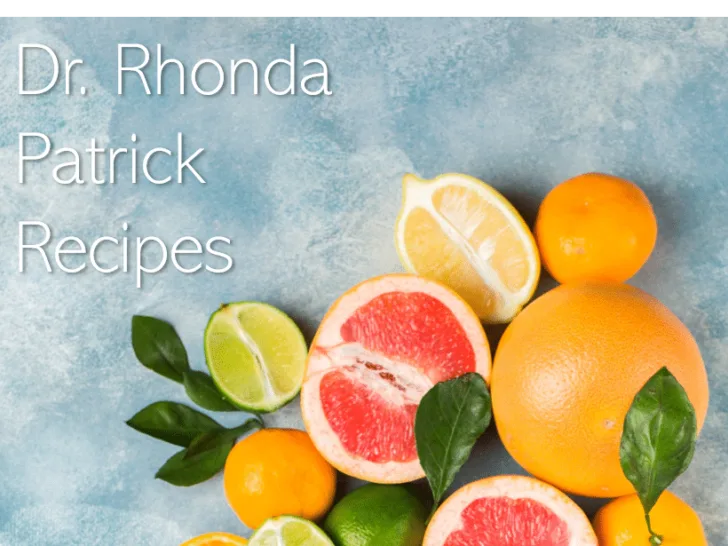Some of the links in this post are affiliate links. This means if you click on the link and purchase the item, we will receive an affiliate commission from the vendor at no extra cost to you. These business relationships allow us to keep bringing you great EatMoveHack content. All opinions remain our own.
Dr. Rhonda Patrick is a fan favorite here at Eat.Move.Hack. We are bringing you some of Dr. Rhonda Patrick’s Diet Ideas so that you can follow more closely to her plan.
First, a bit of background on Dr. Patrick. Dr. Patrick currently works with Dr. Bruce Ames as a postdoctorate fellow at Children’s Hospital Oakland Research Institute. According to her bio page, she “currently conducts clinical trials looking at the effects of micronutrients (vitamins and minerals) on metabolism, inflammation, DNA damage, and aging. In addition, she is investigating the role of vitamin D in brain function and other physiological functions. In February of 2014, she published a paper in FASEB on how vitamin D regulates serotonin synthesis and how this relates to autism.“
Dr. Patrick’s goal is to help encourage the wider public to think about health and longevity. She recognizes that most people suffer from micronutrients, vitamins, and minerals inadequacies. Her research on aging is focused on whether we can make improvements in longevity using proactive preventative approaches, such as her research on aging and whether supplementation can reverse the damage caused by years of a poor diet.
Read on to learn more about recipes that support her research and studies. Enjoy!
Rhonda Patrick’s Diet – Breakfasts
Breakfast Variation #1:
- Scrambled egg topped with tomatillo salsa
- Sauteed Kale + Garlic topped with olive oil, salt, and mustard powder
- Grapefruit
- Avocado oil, for cooking the eggs and kale
Breakfast #2
- Nut & Berry Cereal – including walnut, pecan, and macadamia nuts + blueberries
- Hydrolyzed collagen powder
- Coconut milk
- Flaxseed
- Occasionally she adds almond butter, yogurt, or VSL #3
Dr. Rhonda Patrick’s Diet – Lunches
Lunch #1:
Smoothie #1
Read more about Dr. Rhonda Patrick’s smoothie in our in-depth guide.
Ingredients:
- large kale leaves (8)
- rainbow chard leaves with stems (4-6)
- baby spinach (3 cups)
- carrots (2 medium to large)
- tomato (1)
- avocado (1 large)
- banana (1)
- apple (1)
- blueberries (1 cup fresh or frozen)
- ground flaxseed (tablespoon optional)
- unsweetened flax milled (3 cups)
1/2 of the above in a single serving.
Smoothie #2
Click this link for more information on making version 2. Ingredients:
- Kale (8 leaves)
- Chard (two rainbow chard leaves and stems)
- Spinach (2 cups)
- Celery (2)
- Parsley (8 pieces)
- Carrot (1 large)
- Tomato (1)
- Apple (1)
- Lemon (1)
- Frozen organic blueberries (1-2 cups)
- Avocado (1)
- Hydrolyzed collagen powder (1/4 cup)
- Water (2 cups of water)
Lunch #2:
- Avocado topped with lemon juice and Wild Alaskan Salmon Roe
- Side of sauerkraut
Dr. Rhonda Patrick’s Diet – Dinners
Dinner #1:
- Cooked vegetables or sauteed spinach
- For protein, baked wild Alaskan salmon or grass-fed fillet steak
Dinner #2
- A large salad packed with greens
- Again, for protein, often baked wild Alaskan salmon or grass-fed fillet steak
Dinner #3
- Chicken bone soup with vegetables and spices
Dr. Rhonda Patrick’s Diet – Motivations for Diet Choices
Breakfast #1 – Scrambled Eggs with Kale & Garlic + 1/2 Grapefruit
Eggs
Eggs are a great way to get choline into a diet. It’s converted by the body into acetylcholine, an essential neurotransmitter. Also, they’re delicious!
Sauteed Kale & Garlic
Kale has a ton of lutein and zeaxanthin. With all the blue light exposure we get these days, loading up on carotenoids helps protect us from the many effects of blue light. And Kale and garlic are both solid brain foods, keeping us sharp and smart. Eat up.
Tomatillo Salsa
Tomatillo salsa is not only pretty (and punched up with flavor for eggs) but packed with health benefits. These little green gems are packed with tomatine which research shows can be great for building muscle mass.
Grapefruit
Ok, there are SO many good reasons to eat grapefruit! it’s full of good things like ferulic acid which can have anti-inflammatory and anti-carcinogenic benefits. There are a ton of great ways to eat this power fruit. Add it to a smoothie, roast it for a warm treat, or eat it cold. Good any way you slice it!
Avocado Oil
It’s full of good fats and with a high smoke point. It’s a versatile and healthy way to cook.
Mustard Powder
Cook crunchy veggies and toss it in with tuna or chicken salad for a little kick. It helps convert glucosinate into isothiocyanates – which have tons of health benefits.
Breakfast #2 – Nut & Berry Cereal
Who doesn’t love sweet and crunchy with milk for breakfast? Make it your own by choosing which nuts, berries, and milk to use. Almonds, walnuts, macadamia nuts all sound delicious. Almond and coconut milk are great options to get it all down. Throw in other healthy goodies like raw cacao nibs, nut butter, or unsweetened coconut for crunch and variety. Any way you throw it together, you’re getting good fats, lots of minerals, and all the great energizing and anti-aging vitamins packed into berries.
VSL#3
Rhonda adds VSL#3 to replenish her gut microbiome. She opts for the VSL#3 in sachets (as opposed to pills), which contain 450 billion active probiotic cells per serving.
Lunch #1 – Smoothies
Rhonda rotates between a variety of smoothie recipes (example ingredients listed above). The base of most of her smoothies is kale, chard, spinach, and avocado. For her smoothie recipes, you can check out our link here – which includes all the information you will need.
Lunch #2 – Avocado with salmon roe and sauerkraut
If you haven’t tried salmon roe yet, it’s worth a try. It’s packed with omega-3 fats and tons of brain health benefits. On top of that, it’s pretty darn tasty! Throw on sauerkraut and you also get all the benefits of a fermented fiber, packed with probiotics that get your gut bacteria in optimal immune health.
Roe, kraut, and avocado is a solid, and tasty, power lunch. And think of how pretty it’ll look on your plate!
Dinner #1 – Cooked Vegetables & Baked Wild Alaskan Salmon
There are so many good reasons to eat cruciferous veggies, such as:
- Spinach
- Collard greens
- Bok choy
- Broccoli
- Brussels sprouts
- Parsnips
They’re super healthy on their own but sprinkle on some mustard powder for extra flavor kick and the bonus of making those benefits more accessible to your body.
Folate in Green Vegetables
Cooked vegetables like sauteed spinach are very high in folate. Folate provides a precursor that makes a DNA nucleotide called thymine. Every time you repair a damaged cell or make a new cell in your liver, muscle, brain, etc., you need to make new DNA which means you need folate. Folate was also very recently shown to increase the growth of stem cells, which is important because stem cell pools deplete with age and are a major cause of organ aging and dysfunction. Folate has recently been shown to play a role in protecting telomeres, the tiny caps on the ends of chromosomes that are a biomarker for age because they get shorter every year.
A recent study showed that mothers with highest folate levels had newborns with telomeres 10% longer and every 10 ng/ml increase in serum folate levels, newborns had a 5.8% increase in telomere length which actually suggests that maternal nutrition may actually play a role in determining the length of telomeres that we have to start with.
Wild Alaskan Salmon
Salmon is a great way to get EPA, which is a terrific and effective anti-inflammatory fatty acid. It’s a significant part of brain health and has shown to stave off brain aging. Who doesn’t want that?
Adding salmon to your diet 2-3 times a week is an easy way to get those brain health benefits. There are tons of easy ways to eat salmon more often. You can find recipes for roasted, sous-vide, smoked, or grilled. Find one that you love, and make it a weekly go-to.
Dinner #2 – Large Salad & Grass-Fed Filet Steak
Not in the mood to cook? Throw together a big salad for a powerful micronutrient dinner. Mixing different types of greens not only adds crunch and flavor but a variety of vitamins and minerals. A dressing with ACV means you get the gut benefits of a fermented vinegar.
Don’t forget to add a protein! Salmon is an easy go-to for brain health benefits. But if you’re looking for a source of iron, b12, or zinc, you can’t go wrong with grass-fed steak.
You can also learn more about diet and nutrition from Eat Move Hack’s other blog posts.
If you enjoyed learning more about Dr. Rhonda Patrick’s diet, you may also enjoy:


















